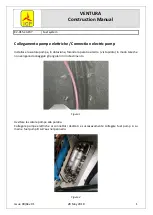
Flight Manual for Gas Balloons of Type NL-STU
Issue 2.0
May 02, 2016
Page 3-6
3.8 Malfunction and defect of the parachute
A trial pull of the parachute must be carried out before take-off to check the functionality of the
parachute. More serious defects can be detected by a slackening of the envelope tautness and
possibly by the sound of the lifting gas escaping.
3.8.1 Defect of the parachute and parachute line
If the parachute can no longer be operated during flight, the balloon can be made to descend
by:
a.) waiting until the lifting gas cools naturally or
b.) dropping several bags of ballast so that the balloon rises above its pressure ceiling. This will
eventually cause the balloon to lose lifting gas and start a steady descent. The quantity of bal-
last to drop depends on the quantity of flight ballast available and the change in temperature of
the air and the lifting gas during the descent.
The following procedure must be observed in this case:
3.8.2 Conspicuously low pulling force required to open the parachute
If it is possible to pull the parachute with little resistance, the parachute line may have caught on
the pull-down belts. If this is detected, the following procedure must be observed:
•
On the ground:
Waiting:
Wait until the balloon begins to descend naturally and, depending on the alti-
tude, ballast reserves and distance from the suitable landing site, carry out a
moderate or forced descent.
Obstacle:
If it is necessary to avoid an obstacle on the ground, the rate of descent must
be reduced in time. It must be ensured that not too much ballast is dropped, to
prevent the balloon from rising back up to the pressure ceiling.
Landing:
After touch-down, the balloon must be held down on the ground by means of
additional loading.
Passengers:
Passengers must not leave the basket until instructed to do so by the pilot.
Parachute:
Pull firmly on the parachute in an attempt to free the tangled parachute line. If
the problem cannot be eliminated in this way, the balloon must be deflated.




































